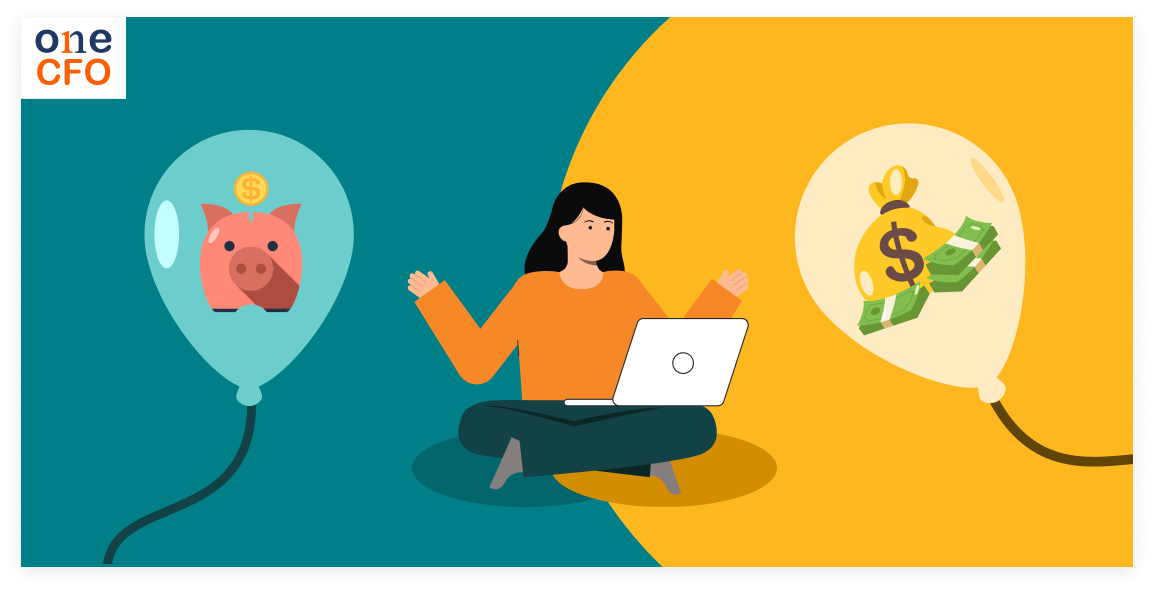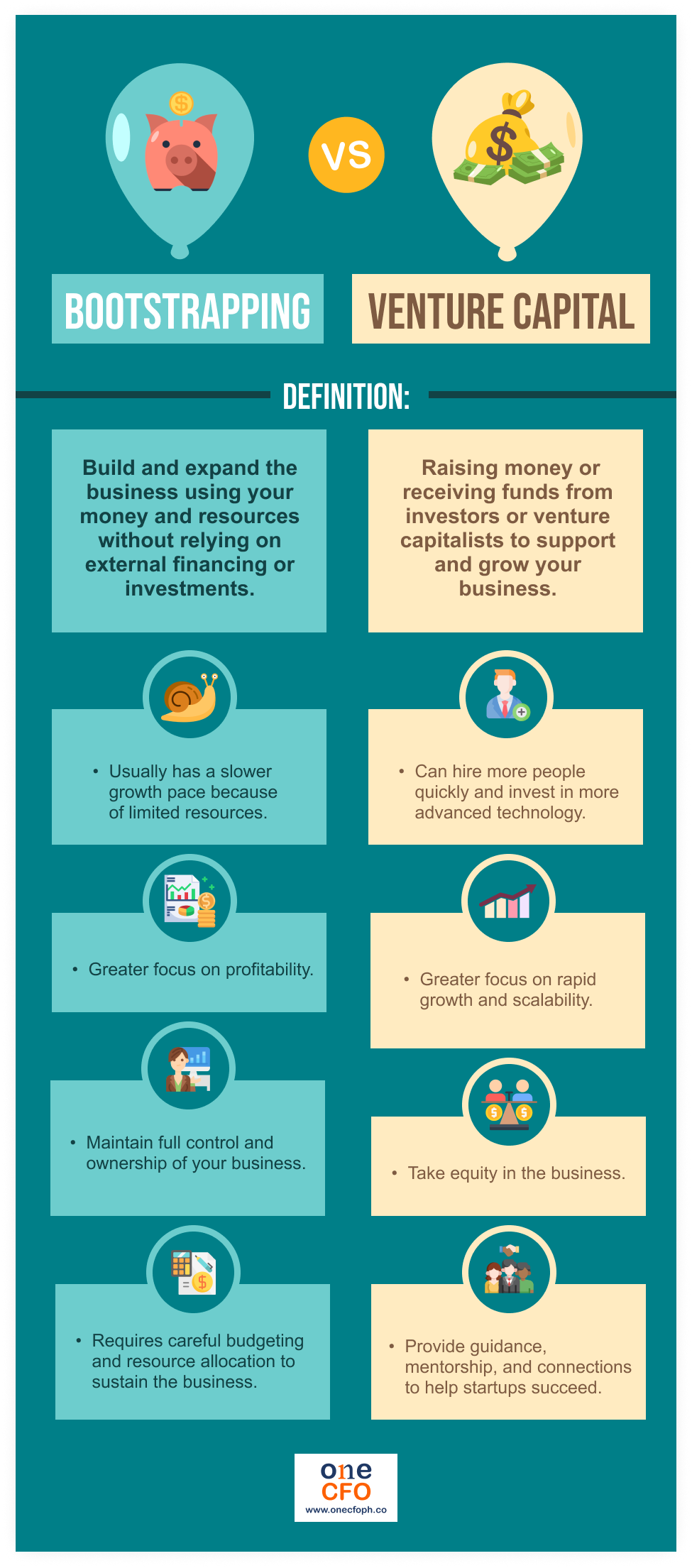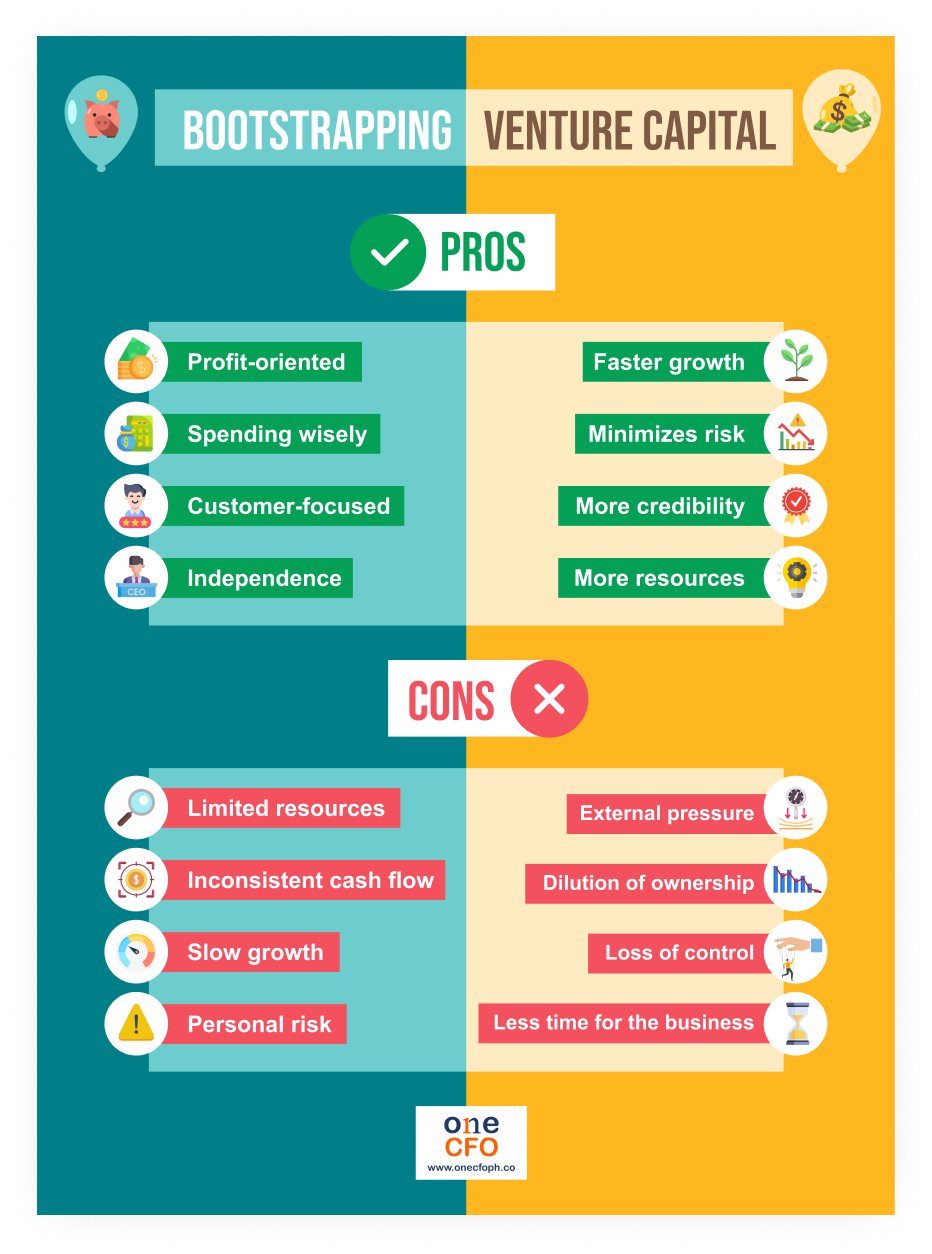
September 21, 2023 | 9:52 pm
Table of Contents
For any startup founder, funding is crucial to bringing your ideas to life and can make or
break a company's success. Two popular methods of obtaining funding are bootstrapping and
venture capital. But which is the best way to fund your startup?
Bootstrapping is a term commonly used in the startup world, referring to starting a business
with little to no external funding. On the other hand, venture capital means funding your
startup with the help of investors or venture capitalists (VCs).
Choosing between bootstrapping and venture capital is not a black-and-white situation. Read
on to learn when to bootstrap or get venture capital. This article examines each option's
potential benefits and drawbacks, helping entrepreneurs decide which option is aligned with
their goals.
What is the difference between bootstrapping and venture capital?

Bootstrapping means running and growing your startup
without outside funding or investors.
As the phrase goes, founders must "pull themselves up by their bootstraps," meaning they
only rely on themselves for funding and growth. Their funds mainly come from savings,
friends and family borrowings, or initial sales.
Since there is more at stake for the founders when they bootstrap, they highly focus on
building a solid product and team. They are also more profit-oriented since they need the
revenue to continue running their business.
Because of limited resources, bootstrapping can be a slow way to grow your company, but
you’ll also have more independence as a founder.
Meanwhile, venture capital (VC) refers to
raising money or receiving funds from investors or
venture capitalists who believe in the company's potential. Founders use the money they
raise to develop their products much faster, hire more people, and invest in technology or
tools for scalability.
In exchange for investing money, venture capitalists take equity in hopes that the business
will have a hypergrowth. Additionally, investors provide startups with guidance and
connections the founders can use to scale the business further. However, this could also
mean less ownership and control of your company.
Pros and cons of bootstrapping vs. venture capital
Two primary routes to secure funding stand out when embarking on your startup journey: bootstrapping and venture capital. Each approach presents a distinct set of advantages and drawbacks. Understanding the pros and cons of each option is crucial in making the right choice for your startup.

Advantages of bootstrapping
Bootstrapping offers unique advantages that resonate with startup founders seeking autonomy, creative freedom, and financial control.
Profit-oriented
One advantage of bootstrapping is that it forces founders to become profit-oriented.
Bootstrapping means the business relies on its revenue and profits to continue operations,
so profitability becomes the business owner’s main priority.
A profit-oriented mindset fosters financial sustainability. One has to be conservative and
focus on how to cover expenses and generate surplus income to reinvest in growth. Doing so
also reduces the vulnerability of businesses during economic downturns.
Spending wisely
Additionally, bootstrapping teaches founders to spend every peso wisely. Bootstrapping
helps businesses achieve more with less, with every peso maximally utilized and finding ways
to reduce business expenses.
Proper cash flow management and efficient
resource allocation are essential in wise
spending. When the business operates efficiently, it can quickly generate profits and
reinvest for growth.
Customer-focused
Bootstrapping also pushes businesses to focus on customer satisfaction to realize a profit.
Since they mainly rely on their customers to keep the business going, they need to develop a
product the customers will genuinely love.
Building a solid customer relationship will help refine your business and reach your ideal
product-market fit faster. Knowing your customers will also improve your user retention in
the long run.
Independence
Lastly, the most attractive part of bootstrapping is founders have complete ownership and
control of the business.
There is no need to answer to a board of directors or investors, who may have priorities
different from yours. Bootstrapped companies control the company’s direction and
strategies.
Regarding ownership, even with co-founders, your share can still be worth more than that of
the founders of VC-funded startups. Investors take on equity whenever they invest, diluting
your company ownership in return.
Disadvantages of bootstrapping
While bootstrapping can be an empowering path for startups, it’s not without its challenges and disadvantages.
Limited resources
One of the significant drawbacks of bootstrapping is limited resources. Founders only depend
on their funds or debt capital and may need more money to reinvest in the business.
Without additional money, the founders can’t easily hire star talent, invest in technology,
or improve their product or service. The lack of resources is also why bootstrapped startups
are much harder to scale.
Inconsistent cash flow
Since startups don’t rely on funds from external investors but instead on revenue generation
to keep the operations going, this can lead to inconsistent cash flow. They need to get hold
of their cash flow to extend the cash runway.
Cash runway refers to the number of months your business can operate before it runs out of
money. Ideally, you should have 12 to 18 months’ cash to run your
business without
additional funding.
Slow growth
Consequently, having limited resources means slower growth. Bootstrapped startups with
limited capital constrain their ability to invest in growth initiatives like marketing,
hiring, product development, or expanding to new markets.
Bootstrapping offers little competitive advantage compared to businesses that are VC-funded.
Unlike VC-funded companies, bootstrapped businesses may not have the budget to run extensive
marketing campaigns, limiting their ability to reach and acquire new customers.
Bootstrapped startups may also be slower to introduce new offerings and improvements as
innovating and developing require investment.
Personal risk
While business is not guaranteed success, bootstrapping comes with a considerable risk since
it involves using personal savings or assets to fund the business. If the business struggles
or fails, the founder's finances are at risk.
Many factors affect startup failure, such
as poor cash flow management, flawed business
models, poor products, etc. With all these factors, startup founders may adopt a more
conservative approach to growth to avoid the significant risk of failure.
Advantages of venture capital
With its deep pockets and strategic guidance, venture capital offers compelling advantages to startups aiming to transform their innovative ideas into thriving businesses.
Faster growth
When getting venture capital funding, your startup can enjoy much faster growth. VCs invest
their time and money so the business can focus more on developing growth strategies.
VC funding allows startups to embrace emerging technology and invest in research and
development to enhance products or services. With funding, startups can also allocate funds
for aggressive marketing campaigns to increase brand visibility, attract new customers, or
retain existing ones.
Minimizes risk
Unlike bootstrapping, venture capital minimizes risk since you’re not using personal funds.
Nevertheless, it’s important to remember that while you don't need to repay the equity
investment in case your business faces challenges, there is still an expectation for your
business to succeed and generate returns for your investors.
Less risk also means more freedom and peace of mind for the founders. You can focus better
on scaling your business without worrying about losing personal funds.
More credibility
When a reputable VC firm invests in a startup, it signals to the market that experienced
professionals have thoroughly evaluated the business model and believe in its potential for
success. This validation is powerful in building credibility.
Moreover, other investors will also support your business when they see other VCs invest in
you.
More resources
Aside from the funding, you can also benefit from your investors' expertise and network. VCs
have extensive industry knowledge and experience helping startups make informed strategic
decisions.
Moreover, VCs can connect you to the right people with their extensive networks. Startups
can leverage this network to establish partnerships, secure customers, or access new
markets.
Disadvantages of venture capital
Startup founders who opt for venture capital funding often navigate a landscape filled with high expectations, loss of control, and potential conflicts with investors.
External pressure
One disadvantage of taking in venture capital is the added pressure to grow quickly. VCs
will constantly track your progress, monitor your KPIs, and push you to achieve explosive
growth so your business gets a high valuation.
VCs typically aim for a profitable exit from their investments within a few years. So, your
business has to dominate the market and generate revenue immediately.
Dilution of ownership
Every time you take in money from VCs, you give away equity or a portion of ownership in
your business. Doing so means you’re diluting your shares in the company, which can limit
your control.
Tip: When taking in venture capital, ensure that you have proper equity management protocols
to track how much ownership of the company you’re giving away.
Loss of control
When you have limited or less control of your company, making business decisions can be more
challenging. Depending on your agreement with the investors, you may need to consult them
for every major decision. They may also demand a seat on your board of directors to gain
more rights and control over the company.
Having investors also becomes a problem if your visions for the company don’t match. There
will be a clash of opinions, leading to misunderstandings or arguments.
Less time for the business
Raising money also takes a considerable chunk of time. Founders must send proposals, set up
meetings, negotiate back and forth, and follow due diligence protocols. On top of that,
founders need to constantly update their investors about the company’s progress after
sealing the deal.
The time the founders spend raising capital and maintaining relationships with investors is
also the time they lose personally handling their business.
Which is better for your startup: bootstrapping or venture capital?
Aside from the pros and cons, there are also other considerations you should think about when deciding how to fund your startup.
There is no right or wrong answer when choosing between bootstrapping and venture capital. The choice mainly depends on your product and market, appetite for risk, and other personal preferences. Here are some questions to ask yourself when deciding:
What kind of product do you have?
The type of product, business idea, and market you have are significant considerations when
deciding how to fund your startup, especially if you’re leaning toward venture capital
funding.
Venture capitalists look for highly scalable companies capable of challenging the top
businesses in the market. VCs invest money in your company because they expect you to grow
into a multimillion-dollar company in a short amount of time.
To grow explosively, you need to have a large, totally addressable market and focus your
energy on scaling. If your business idea is in a “winner takes all” market, where the
one
who reaches the top first will dominate the market, then taking in venture capital would be
best.
Venture capital is also a good option if your company needs to grow significantly first
before you can make a profit. Remember, scaling your company can be challenging if you’re
only burning money and cannot earn any profit. And if the only way your business can profit
is by scaling or growing first, then VC funding is the better option.
However, not all businesses can reach hyper-growth, but that doesn’t mean your business is
any less successful! Bootstrapping allows you to run your company at your own pace and
remove the external pressure to grow explosively.
There are businesses like Mailchimp that became
multibillion-dollar companies without any
external funding. On the other hand, there are also companies like Shopify, who bootstrapped
first for years before seeking venture capital.
What is your appetite for risk?
Both bootstrapping and venture capital come with risks, so you need to assess what kind of
risks you are comfortable with.
The company risks its money and savings when bootstrapping to run the business. They need to
minimize cash burn and have enough cushion to take themselves
over bumps in the road. Every
financial decision can make or break the company, so it’s best to be careful.
Since bootstrapped companies have limited resources, growth will also be slow. However,
delayed growth isn’t necessarily bad since it also means running the company can be less
chaotic. Businesses can also choose to grow their company only up to the size they can
sustainably run.
On the other hand, venture capital funding can be risky. Investors always expect you to grow
exponentially, so delays or slow growth can mean VCs not funding your next rounds. An abrupt
cut in funds can be dangerous, especially if your company isn’t revenue-generating yet.
Most businesses seeking venture capital aim to innovate or disrupt the market, which is
already a huge risk. The high risk, however, can also pay off a high reward with the proper
guidance and strategies.
VCs also receive shares of your company when they invest their money. Giving out equity can
be risky if you don’t know how to manage it, especially if you provide equity compensation
to your employees. Failure to manage or monitor the company’s equity structure can cause
business owners to unintentionally dilute their ownership, which can cause issues when
voting or deciding the company’s future.
Since your investors become part-owners of your startup, you should ensure you share the
same vision for your company. Always do your research and due diligence before accepting
your investors' money. Also, assess if you and your investors can work well together and if
they can bring your company in the direction you want to take.
Choosing the path to follow
Choosing between bootstrapping and venture capital is a no-one-size-fits-all scenario. Both
paths offer distinct advantages and disadvantages; the choice ultimately depends on your
business vision, goals, and circumstances.
Bootstrapping might be your path if you value autonomy, control, and self-sufficiency. On
the other hand, venture capital can set the right way toward rapid growth and market
domination.
Whichever path you choose, the key is to keep your eye open by understanding your decision's
implications and nuances. An outsourced CFO service with knowledge and expertise in the
startup scene can be pivotal in helping you make the decision.
OneCFO brings financial expertise by
conducting financial assessments, analyzing risks, and
assisting in cash flow management to determine your funding strategy.
Take the first leap in starting your business - OneCFO will be with you every step of the
way.
Visit us at onecfoph.co or contact us at [email protected] to
learn how we can help you with your fundraising needs.
Read our disclaimer here.